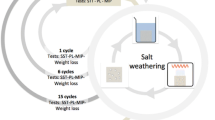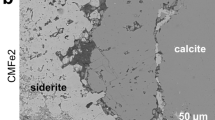Abstract
Here-named “autoconglomerate” comprises rounded lime-mudstone clasts of various shape (spherical, prolate, discoidal, tabular, and irregular) and size (a few millimeters to 15 cm in long diameter). Autoconglomerate is mainly interbedded with ribbon carbonate (alternating limestone and dolomitic shale) and subordinately present in the upper part of fractured lime-mud-stone bed, which is gradational to lime-mudstone downwards and commonly capped by marly shale. We coin “autoconglomeration” for the formative process of autoconglomerate, which is most likely due to compaction, fluidization, and dewatering during consolidation. The rounding process (i.e., autoconglomeration) is probably enhanced by immiscibility and surface tension of lime-mud. Autoconglomeration is analogous to autobrecciation of limestone, but furthered.
Similar content being viewed by others
References
Bates, R. L. and Jackson, J. A., 1987, Glossary of Geology (third edition). Alexandria Virginia, American Geological Institute, 1–788.
Bathurst, R. G. C., 1975, Carbonate sediments and their diagenesis. Amsterdam, The Netherlands, Elsevier Scientific Publishing Company, 1–658.
Demicco, R. V. and Hardie, L. A., 1994, Sedimentary structures and early diagenetic features of shallow marine carbonate deposits. Society of Economic Paleontologists and Mineralogists Atlas Series 1, 1–265.
James, N. P. and Choquette, P. W., 1990, Limestonethe sea floor diagenetic environment. In: Mcllreath, I. A. and Morrow, D. W. (eds.), Diagenesis. Geoscience Canada Reprint Ser. 4, 13–34.
Kennedy, W. J. and Garrison, R. E., 1975, Morphology and genesis of nodular chalks and hardgrounds in the Upper Cretaceous of southern England. Sedimentology, 22, 311–386.
Molenaar, N. and Zijlstra, J. J. P., 1997, Differential early diagenetic low-Mg calcite cementation and rhythmic hardground development in Campanian-Maastichtian chalk. Sedimentary Geology, 109, 261–281.
Stanistreet, I. G. and Hughes, M. J., 1984, Pseudoconglomerate and re-examination of some paleoenvironmental controversies. Geology, 12, 717–719.
Wignall, P. B. and Twitchett, R. J., 1999, Unusual intraclastic lime-stones in Lower Triassic carbonates and their bearing on the aftermath of the end-Permian mass extinction. Sedimentology, 46, 303–316.
Author information
Authors and Affiliations
Corresponding author
Rights and permissions
About this article
Cite this article
Chough, S.K., Kwon, Y.K., Choi, D.K. et al. Autoconglomeration of limestone. Geosci J 5, 159–164 (2001). https://doi.org/10.1007/BF02910421
Received:
Accepted:
Issue Date:
DOI: https://doi.org/10.1007/BF02910421




